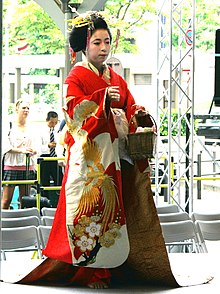Tayū

Tayū (太夫) are the highest class of traditional Oiran in Japan. Traditionally the highest class of Oiran, tayū were distinguished historically from other entertainers by the quality of their intensive training from a young age in numerous traditional artforms, and that they lived and worked in Kyoto, the capital of Japan, which remained the center of culture when the capital moved to Tokyo.[1]
Tayū were known for their training in Japanese tea ceremony, kōdō, ikebana, Japanese calligraphy, poetry, dance, singing, and the playing of traditional instruments, such as the koto.
History
[edit]Tayū differed from lower ranks of oiran by the social class of their customers and the services they offer. Oiran, being prostitutes and Tayū, being high ranking Oiran. Traditionally, tayū catered for the uppermost echelons of society, including the nobility and the imperial court. Tayū were recognised as a group in the beginning of the Edo period. Due to the limited size of their clientele, they were never numerous; during their peak there were approximately 40 tayū working in Kyoto in the Shimabara district.
Tayū have survived into the modern day in Shimabara, Kyoto, having been allowed to continue practising the cultural and performing arts traditions of their profession.
The most famous tayū in history was Yoshino tayū (吉野太夫), who lived in the 17th century.[2] Trained from the age of 7, she quickly mastered the many arts required to be a tayū, and made her debut at the age of 14, immediately becoming a sensation. Yoshino was well-known for her beauty, skill and erudition. Yoshino is buried in the Jōshō-ji temple in Kyoto. Every year on the second Sunday in April, near the anniversary of her death, there is a procession of tayū to the temple, where a ceremony is held.
Appearance
[edit]While entertaining, tayū wear elaborate kimono and hair ornaments weighing more than 2 kg (4.4 lb). Unlike modern-day oiran and geisha, but similarly to some apprentice geisha, they do not use wigs for their traditional hairstyles, but instead use their own hair.
Tayū wear white face makeup and blacken their teeth. Tayū are accompanied by an older female attendant and two kamuro (young girls wearing red livery bearing the tayū's name).
When outdoors, tayū wear distinctive extremely high platform sandals, which require a special mode of walking in order to look elegant, and also an attendant for support. This and many other aspects of the tayū's appearance were copied by the oiran, most notably in the oiran-dōchū, a procession where the oiran processes to meet a customer.
See also
[edit]References
[edit]- ^ Williams, Philip F. (2010). Asian Literary Voices: From Marginal to Mainstream. Amsterdam University Press. pp. 23–25. ISBN 978-90-8964-092-5.
- ^ Shirane, Haruo (2008-04-21). Early Modern Japanese Literature: An Anthology, 1600-1900 (Abridged Edition). Columbia University Press. pp. 23–34. ISBN 978-0-231-51614-3.
